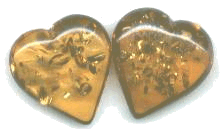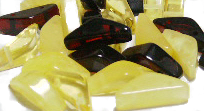
Amber
This gem is not a mineral but an organic substance, formed from the hardened resin of such trees as the pine Pinus succinifera and the Mexican Hymenea it is uncertain exactly how long amber takes to form, some geologists state 25 million years, others 40 - 60 million.
Young amber (around 15 million years old) is called copal.

Unusual Emerald-Cut Amber with Insect Inclusion
Valued since ancient times, the name originates from its electrical properties and many cultures attributed amber with magical powers, since it becomes charged with electricity when rubbed.
Amber was so admired by the Romans that some amber ornaments were more highly prized than slaves.
The colour of amber depends on its location in the tree:
- Pale emperor/butterscotch/bonefrom the central core of the trunk, where it was deprived of oxygen
- Blackfrom the lower bark where there was a lot of dirt
- Cognaccoloured by a little dirt
- Greenfrom the chlorophyll of mosses and lichens which lived on the bark
- Honeyfrom clean bark.
Amber gives a pine smell if touched with a hot pin. Trapped air bubbles make amber cloudy, if heated, cloudy amber becomes clear.

Pressed Ambroid Beads

'Blue' Burmite
Amber scraps are often heated and pressed together to form 'ambroid', this makes the beads clearer than unheated amber.
Burmite Is the variety of amber found in Burma, which has a blue tint.| Latest Trends | Ordering Information | debbie@silkpixie.com | Delivery & Returns |


